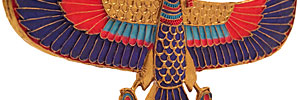Isis was the Egyptian goddess of Magic and Life - the patron saint of mothers, women, and children. She was also known as the goddess of healing. Her name literally means 'Queen of the Throne', which was portrayed by the throne emblem on her head. The hieroglyph of her name meant 'she of flesh' (or mortal) originally, and she may have represented historical queens and female deities. Ancient Egyptians believed that Isis's tears of sorrow for her dead husband Osiris caused the Nile River to flood every year. Osiris was killed by Isis's evil brother, Set, the god of destruction and chaos. It was believed that Set chopped Osiris into pieces and threw them into the Nile River, letting the animals consume his remains. All of the pieces are said to have survived, except for one.
Isis's origin is uncertain, but she is believed to have come from the Nile Delta. Unlike other Egyptian deities, she didn't have a centralized cult at any time throughout her worship. The first historical mentions of Isis are found as far back as the Fifth dynasty of Egypt, when the first literary inscriptions are found. Her cult became prominent later in Egyptian history, and it absorbed the cults of many other goddesses. Eventually, her following spread outside of Egypt throughout the Middle East and the Roman Empire. Temples were constructed and dedicated to her as far away as the British Isles. Pockets of her worship remained as late as the 6th century in Europe.
Cold Cast is a modern method of casting sculptures using a mixture of resin and powdered polymer materials. The finished sculpture has a surface which looks very similar to traditionally cast material, but tends to be much lighter.














